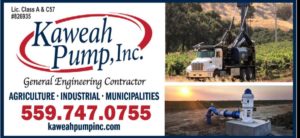The Madera County Water Market Partner Webinar was held on Thurs., April 30, 2020 organized by Stephanie Anagnoson, Director of Madera County’s Water and Natural Resources Department, assisted by her colleague Jeannie Habben. The County had obtained a grant to help the dozen GSA entities in the county understand whether and how water markets might be included as part of the effort to meet SGMA requirements.
The meeting carried the title “Understanding Concerns,” about how an allocation program could work. This was an information only session – no decisions taken – with a presentation of some 45 slides followed by a short Q & A session.
Stearns and West consulting firm provided the technology which was designed to allow both online and telephone participation, presentation of slide sets and survey questions in real time, all with a bilingual English / Spanish component. There were technical issues getting folks signed in but it started virtually (sorry) on time. The opening minutes were a little rough with the usual assortment of open mics and background noise.
Habben made some opening remarks welcoming the group and explaining that this was the first using the webinar technology. She identified the meeting objectives to share information on how a water market strategy could tie in with SGMA. The roll call of all 102 meeting participants was taken including those online and on the phone.
Cici Vu with the Stearns and West firm laid out the call mechanics, guidelines and agenda. She served throughout as the moderator, introducing various speakers.
The proposed water market timeline continues through this year, with a goal of conducting a pilot project in 2021 This fall, the plan is to have a legal framework established with rules in place early in the new year. This schedule had been presented at the Feb. 25 meeting, the first held by this group.
Stephanie Campbell of S & W provided some feedback from the first workshop. Key issues were setting, managing and tracking tradeable allocations and how year-to-year carryovers could work. Questions about irrigated versus non-irrigated land were identified along with water supplies and water quality protections for domestic and residential wells. Campbell was the recorder for both sessions, as well.
Stephanie Anagnoson and Greg Young began, showing a map of the subbasins within Madera County, depicting the territory covered by the GSAs responsible for the subbasins, with the county itself responsible for the white areas.
Young began by describing that the native groundwater (NG) from rain and natural seepage, available for pumping amounts to about a half-acre foot per year. It was here that the “gorilla in the room” was evident. No surprise, the subbasins are being significantly  over drafted.
over drafted.
In the Chowchilla Subbasin, there are a total of 42,500 acres with 35,000 irrigated using 82,000 af/yr but with only 21,000 af/yr of NG available. In the Madera Subbasin, there are 178,000 acres total with 85,000 irrigated using 190,000 af/yr but with only 90,000 af/yr of available NG. Therefore, SGMA requires a reduction of NG use in two subbasins of 160,000 af/yr by 2040.
Young said there are a variety of ways to achieve this reduction, including land use restrictions, well drilling moratoriums, pumping fees, easements and allocations. The purpose of this study funded by a grant is to see if allocations with trading can be one of the tools to achieve this reduction.
The next presenter was Janet Clements of Corona Environmental Consulting who spoke about the many issues around water markets. (No one commented on her firm’s currently unfortunate name. The website shows this national engineering firm apparently derives its name from the sun’s corona, the ring of bright gases around our star.)
Clements identified market basics as needing to cover the water budget… i.e. the water available, individual trading allocations, measurement of groundwater use and perhaps most importantly, stakeholder buy-in.
In Madera County, she said, it is primarily ag irrigation, not industrial use, so water market allocations may allow water to be used by different users in a voluntary way, possibly  decreasing the negative impacts of reductions required by SGMA. As many know, a water market of allocations does not involve water movement. Instead, one property owner may forgo his / her use of ground water to allow another to use more from the same aquifer.
decreasing the negative impacts of reductions required by SGMA. As many know, a water market of allocations does not involve water movement. Instead, one property owner may forgo his / her use of ground water to allow another to use more from the same aquifer.
(Not to be negative, but one knowledgeable observer notes that with so much of the irrigated land in permanent trees and vines, especially almonds, the opportunity for farmers to change up water use, swapping with neighbors, seems to him to be limited.)
Concerns raised at the earlier meeting involved the potential for big growers to “corner the market” which might require some limits on how much a buyer could purchase. Similarly, profiteering or “flipping” water would be a concern, perhaps requiring a rule prohibiting the re-
sale of allocated water. Issues around commercial and residential developments, too, were noted since allocations are not permanent. Obviously, residential and commercial developments in this system would need to obtain permits and keep overall SGMA compliance in mind. Another question concerned the potential for multiple year trades, but those allocations thus purchased could not be used in a single year.
In any allocation program, carryover can perhaps provide greater flexibility for buyers and sellers and during times of ample groundwater levels. On the other hand, an allocation agreed to in one year might have adverse effects in another dryer year. One option, of course, is that no carryover be allowed.
Issues around the marketplace also include equal access to information, confidentiality of information and that transactions costs be kept to a minimum. The structure for the market could include bilateral or “coffee shop” sales. Also, brokers can be used, often real estate brokers. Another method could be an online bulletin board, sort of a “Craig’s list.” Auctions or reverse auctions can be held or there can even be electronic clearinghouses or a “smart market” with bids submitted to a market administrator using algorithms to match buyers and sellers.
During her presentation, listeners were invited to participate in online surveys in real time to register their levels of concern around these issues.
The presentation concluded, Stephanie Anagnoson reiterated her invitation to all participants to submit their questions, concerns and recommendations directly to her office. She explained that work this summer and fall will be to develop the structure, rules and documentation for a water market allocation pilot program.
The meeting ended as scheduled about 5 p.m. Water market documents including the slides presented can be found at https://www.madercountywater.com/county-gsa-advisory-committees/
DISCLAIMER OF RESPONSIBILITY; Waterwrights strives to provide his clients with the most complete, up-to-date, and accurate information available. Nevertheless, Waterwrights does not serve as a guarantor of the accuracy or completeness of the information provided, and specifically disclaims any and all responsibility for information that is not accurate, up-to-date, or complete. Waterwrights’ clients therefore rely on the accuracy, completeness and timeliness of information from Waterwrights entirely at their own risk. The opinions expressed in this report are those of the author and do not represent any advertisers or third parties.
ALL RIGHTS RESERVED. Copyright 2020 by WaterWrights.net
MADERA COUNTY WATER & NATURAL RESOURCES DEPARTMENT
Director Stephanie Anagnoson
200 West Fourth St
Madera CA 93637
stephanie.anagnoson@maderacounty.com
DWR SGMA Identity #5-022.05 and 5-022.6































